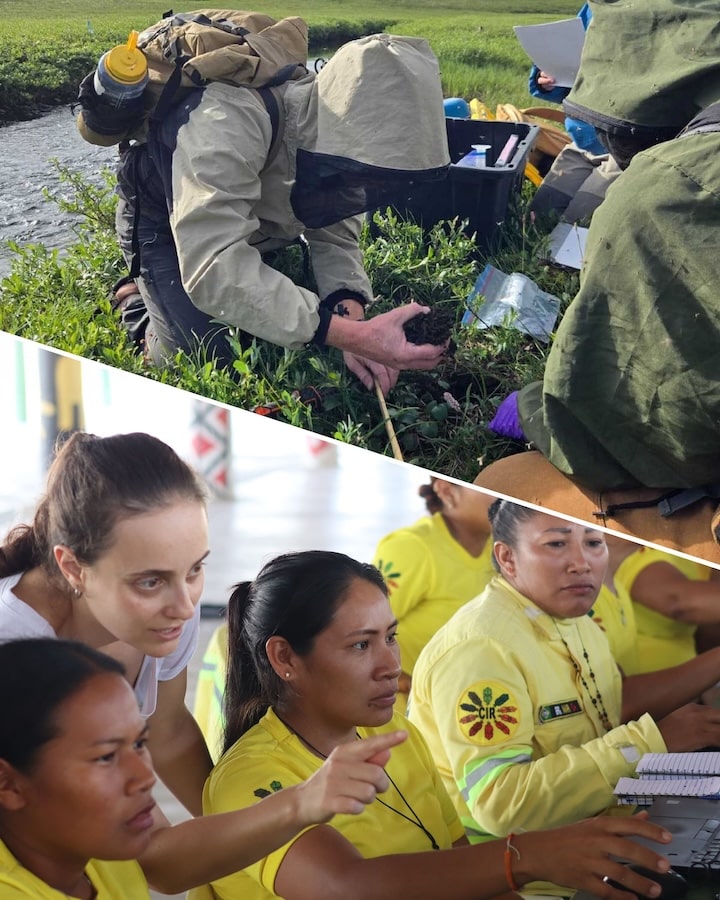A message from President & CEO Dr. R. Max Holmes
I am writing from Belém, Brazil, a city at the edge of both the Amazon forest and the Atlantic Ocean and host of COP30—the thirtieth annual meeting of the parties to the United Nations Framework Convention on Climate Change treaty, what is often referred to as the UN climate conference.
The location of this year’s meeting is significant in multiple ways. The treaty was adopted in Rio de Janeiro, so returning to Brazil is something of a homecoming. And Belém’s location puts particular emphasis on the importance of tropical forests and nature-based climate solutions more broadly.
Woodwell Climate has more than a dozen science and policy experts at COP30 sharing our science, informing negotiations, deepening relationships, and exploring new possibilities. We are advocating for more ambitious climate goals that take into account emissions from permafrost thaw, wildfires, and other ecosystem changes; for equitable, effective finance mechanisms that can get money flowing to the people best positioned to protect tropical forests; for science-based national adaptation plans and indicators that will enable us to track our progress toward global resilience.
It is exciting, even exhilarating, work. And yet, the “30” in COP30 raises uneasy questions. This is the thirtieth time the nations of the world have come together to chart a path toward a just, livable climate future. Why is progress so slow? What can possibly be left to negotiate? Is it all worth the effort?
As these questions were bouncing around in my head, I started to wonder what the originators of the process think of where we are. One of those originators, Kilaparti Ramakrishna (known to many as Rama), was among Woodwell Climate’s first employees and is currently a member of our Board of Directors. So I reached out and asked him. In response, he shared an essay he was working on which began this way:
“When we were drafting the United Nations Framework Convention on Climate Change (UNFCCC) in 1991–1992, few of us could have imagined that the negotiations we began would still be unfolding three decades later. But we did know that we were creating something designed to last. The Convention was never meant to be a one-off agreement that “solved” climate change; it was conceived as a living framework, a foundation for continuous, evolving cooperation guided by science, equity, and common purpose.”
That is, in itself, a lofty goal. And by that measure, the UNFCCC has been a resounding success. It has weathered numerous, dramatic, often rapid, geopolitical shifts over the past three decades. Particularly now, in an era of rising nationalism around the world, it is remarkable that any multilateral process should persist for so long. It is an enormous testament to the many negotiators and advocates who have held to that vision and worked tirelessly to advance, however incrementally, a truly global framework for addressing climate change.
Obviously, it has not been without setbacks. One front of mind for many right now is the fact that the U.S. has withdrawn—not just once, but twice. And on that note, Rama had another frameshift to offer. Each time the U.S. has stepped back, progress has slowed. There is no denying that. But the UNFCCC and the Paris Agreement have continued nonetheless. That is because others have stepped into greater leadership and responsibility, and that makes the process, as a whole, stronger in the long run.
And this is a long run. Climate change is a challenge of unprecedented scope and import. It has been decades in the making, and the consequences will span every aspect of society for decades, if not centuries, to come. The U.N. Framework Convention on Climate Change is a correspondingly unprecedented response that cannot be expected to yield results overnight. It remains the only forum for truly global discourse and collaboration on climate issues, and that is invaluable.
So let’s celebrate that this is the thirtieth COP, acknowledging that progress has been slower than any of us would want but recognizing that we are in a much better place than we would be without the U.N. Framework Convention on Climate Change. Let’s also look ahead to COP40, COP50, and even COP60, imagining the world we want in the future and resolving to do everything we possibly can to realize that vision.
That is what keeps me going. That is what keeps Woodwell going. On behalf of all of us, thank you for the privilege of doing this work.
Onward,

Alaska permafrost put at risk by climate change
Researchers are racing to study how fast permafrost is transitioning from carbon sink to source of emissions, with the climate in the balance.
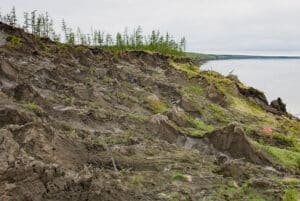
On a blustery day in August, a team of five scientists watched with perverse fascination as saltwater from the Arctic Ocean lapped over the tundra of Alaska’s Prudhoe Bay. They’d spent more than a year studying the phenomenon that’s increasingly common as land ice melts, but had never witnessed it firsthand.
The ground is swallowing homes in this Native village in Alaska. Residents have no choice but to move
The climate crisis is causing the permafrost to melt in Alaska, forcing the village of Nunapitchuk to relocate
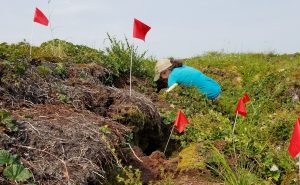
Children splash gleefully in the river as adults cast fishing lines or head into the Alaska tundra to hunt. It’s a scene that has characterized summer days for centuries among the Yup’ik people who have long lived in south-western Alaska, where the village of Nunapitchuk stands. But, with temperatures in Alaska warming nearly four times faster than most parts of the globe, that way of life is about to change.
Homes in Nunapitchuk have been sinking into the permafrost, and residents have decided their only choice is to move the entire village to higher ground.
Continue reading on The Guardian.
Every five years, all 195 signatories of the 2015 Paris Agreement must submit updated plans to reduce their greenhouse gas emissions to limit global warming. These plans, known as Nationally Determined Contributions (NDCs), are key components of the agreement and represent countries’ highest ambitions for emissions reductions over the next decade.
“The NDC is a pledge,” Director of International Government Relations at Woodwell Climate Dr. Matti Goldberg says. “It’s a pledge by a government to reduce their emissions by a certain amount, by a certain time frame. It can also be a pledge of taking certain types of actions. Each NDC also contains plans and measures to put it into action.”
This year, countries must submit their third NDC ahead of COP30 in Belém, Brazil.
How do NDCs fit into the Paris Agreement?
The Paris Agreement is a legally-binding international treaty under the UNFCCC. The treaty states that signatories should work together to limit global temperature increase to “well under 2°C” above pre-industrial levels and pursue efforts to keep the increase below 1.5°C. Nationally Determined Contributions outline how countries plan to achieve this goal and take other measures as part of the global climate effort.
Each NDC must build upon a country’s previous submission and reflect the party’s “highest possible ambition,” according to the Paris Agreement. While parties are legally required to submit an NDC and pursue actions to reach the target, they are “not legally bound to reach the target,” Goldberg says. “It’s a gigantic loophole in a way…although such flexibility is obviously necessary for countries to agree to this, and it does create a structure of pressure.”
After NDCs are submitted, the UNFCCC assesses the combined impact of countries’ NDCs on projected global emissions in a synthesis report. Parties in the Paris agreement also submit a Biennial Transparency Report (BTR) every two years, which outlines each country’s progress made towards accomplishing their NDCs.
“It’s the country’s own assessment,” Goldberg says. “But if a country announces a metric, then others can, of course, also look at whether that metric is being followed. This information creates the basis for civil society and other governments to put pressure on those governments.” Further transparency is created by a process where international experts review each country’s biennial reports.
Despite the ambitious intent of NDCs, Executive Secretary of the United Nations Framework Convention on Climate Change (UNFCCC) Simon Stiell determined last November that previous pledges fell “miles short of what’s needed to stop global heating from crippling every economy and wrecking billions of lives and livelihoods across every country.”
What is in the 2025 NDCs?
NDCs were initially due in February 2025, but with only 13 Parties submitting on time, the UNFCCC Secretariat announced a cut-off date in September to have enough time to prepare its synthesis before the start of COP30 in November. China, the United States, India, the European Union, Russia and Brazil were the world’s top emitters in 2023. Together, these six parties accounted for 62.7% of all global emissions. Of the top greenhouse gas emitters, only the U.S. and Brazil sent in their NDCs as of early September 2025.
The United States submitted its NDC in 2024 under the Biden Administration and set a target of reducing its net greenhouse gas emissions by 61 to 66% below 2005 levels in 2035. After taking office, President Trump issued an executive order announcing the U.S.’s intent to withdraw from the Paris Agreement, which will go into effect in 2026. After January 2026, the U.S. will no longer be required to submit new NDCs or Biennial Transparency Reports.
Despite the country’s withdrawal, Goldberg says the U.S. may see a reduction in greenhouse gas emissions because of its continuing transition from coal to natural gas, renewables and nuclear power — which, according to Goldberg, is driven more by economics and less by policy. Still, Dr. Christopher Schwalm, Vice President of Science at Woodwell Climate, predicts there is “no way” the United States will hit the targets set out in the NDC given the current global political climate. Even if the U.S. does reach its goals, the NDC still does not align with the global 1.5°C limit, according to the Climate Action Tracker. Schwalm calls the 1.5°C target “dead as a doornail.” To reach this goal, we would have needed global greenhouse gas emissions to peak by 2025.
Brazil’s most recent NDC states a goal of reducing greenhouse gas emissions 59% to 67% compared to its 2005 emissions. Goldberg calls it a “pretty ambitious” absolute target for a country classified as a developing country under the UNFCCC. However, the Brazilian climate organization Observatório do Clima states the NDC goals do not align with the global 1.5°C limit.
How could reaching targets in NDCs impact warming trajectories?
Woodwell Climate research scientist Dr. Abigail Lute wanted to see how much of a difference just two of the top-emitting countries’ NDCs could make.
“Are we moving the needle here or not?” she says. “How much are we moving the needle? Are we moving it enough to avoid 2°C? That’s the big picture, to see how ambitious these new pledges are.”
Lute modeled how both the U.S. and Brazil’s promises together could change the global warming trajectory using a “middle-of-the-road” scenario for future greenhouse gas emissions — though, at the moment, that scenario might be more optimistic than our current trajectory, she says.
For the first ten to 20 years after implementing the NDCs, temperatures will temporarily increase. This is due to the reduction in polluting gases such as sulfates that actually have a cooling effect in the atmosphere. After about a decade or two, the reduction in warming gases such as methane and carbon dioxide will cause temperatures to fall.
According to Lute’s calculations, under moderate emissions scenarios, the probability of exceeding 2°C is 25% by 2050 and 78% by 2100. If both the U.S. and Brazil reach their NDC targets, the probability of exceeding 2°C stays about the same for 2050 but drops down to 73% for 2100.
Global warming is expected to reach 1.8°C by 2050 and 2.3°C by 2100 under the medium emissions scenario. With the U.S. and Brazil’s combined NDCs, Lute expects warming to be reduced by about 0.01°C in 2050 and 0.06°C by 2100.
While these contributions may seem small, Brazil and the U.S. only represent two of the 195 parties in the Paris Agreement.
“It’s two of the larger ones for sure, but it’s only two,” Lute says. “If we extrapolate it to everybody, then it can make a meaningful difference…the story here is that everybody needs to contribute. This is a collective problem, and even one large country can’t solve it.”
Scientists have a dire new warning about the state of the planet
Recent climatic developments “mark the beginning of a grim new chapter for life on Earth,” but it’s not too late for radical action.
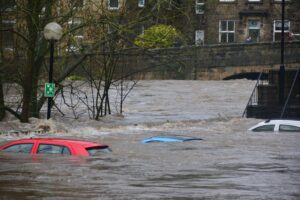
As the end of 2025 approaches, regular folk take stock of the past year, and maybe ponder their New Year’s resolutions. Climate scientists, on the other hand, have been busy parsing mountains of data from the last 10 months, ranging from global temperatures to measurements of polar ice to the costs of extreme weather. Accordingly, their goal for 2026 might be to somehow make world leaders understand that humanity is running out of time to avert catastrophe.
On October 29, Woodwell Climate submitted public comment to the U.S. Environmental Protection Agency’s proposed amendments to the Greenhouse Gas Reporting Program (GHGRP).
Community discusses landslide hazard mitigation at forum
Researchers held a community-focused conversation on landslide hazards and potential mitigation avenues last Tuesday at Kachemak Bay Campus.
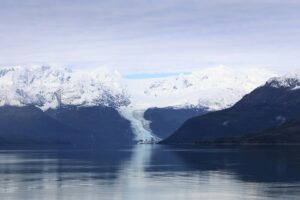
Local and visiting researchers, along with city and state agency representatives, discussed landslide hazard mitigation and demonstrated a community sharing of knowledge during a forum held last week at Kachemak Bay Campus. The conversation also highlighted important roles that community members play in monitoring landslide hazards.
Woodwell Climate Conversations: Road to COP 30
Learn how Woodwell’s science and partnerships are impacting the international stage
Climate Policy Expert Frances Seymour and Dr. Matti Goldberg, Director of International Government Relations reflect on the major themes and outcomes from New York Climate Week, highlighting the momentum and challenges that emerged on the path to COP30 in Brazil.




